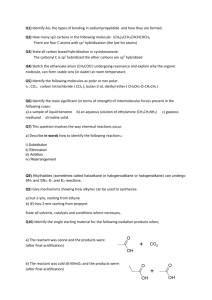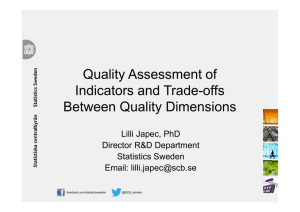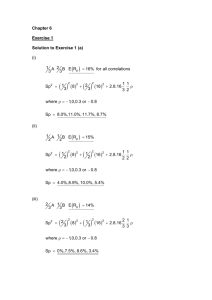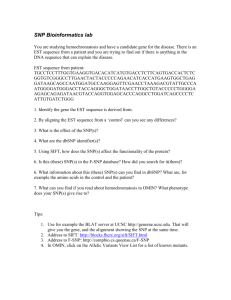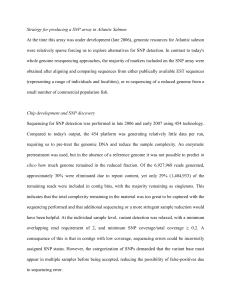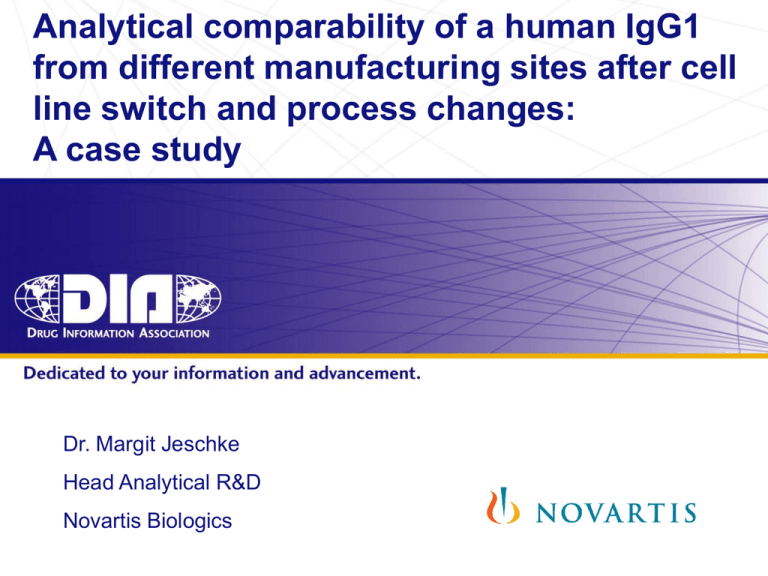
Analytical comparability of a human IgG1
from different manufacturing sites after cell
line switch and process changes:
A case study
Dr. Margit Jeschke
Head Analytical R&D
Novartis Biologics
www.diahome.org
Disclaimer
The views and opinions expressed in the following PowerPoint slides are
those of the individual presenter and should not be attributed to Drug
Information Association, Inc. (“DIA”), its directors, officers, employees,
volunteers, members, chapters, councils, Special Interest Area
Communities or affiliates, or any organization with which the presenter is
employed or affiliated.
These PowerPoint slides are the intellectual property of the individual
presenter and are protected under the copyright laws of the United
States of America and other countries. Used by permission. All rights
reserved. Drug Information Association, DIA and DIA logo are registered
trademarks or trademarks of Drug Information Association Inc. All other
trademarks are the property of their respective owners.
www.diahome.org
Outline
Introduction
Molecular Challenges with mAb1NVS
Results
• Purification Process Performance
• Physicochemical tests
• Biological characterization
• Accelerated Stabilty Study
• Preclinical & PK/PD
Summary
Conclusions & Discussion
Acknowledgements
3 | 2009 DIA Comparability | Jeschke M | 4-Feb-09
Drug substance Drug product
Overview mAb1NVS Drug Substance & Product
PhII
hPoC
DP
50mg Lyo i.v.
Prod. Site
Cell line
Qualities
PhIII
Market
150mg Lyo i.v. & s.c
Basel
PharmOps
SP2/0
CHO
Type A
Type B
Type C
Type D
Type E
PoC quality
PoC quality
Prototype
Prototype
Final market quality
Major change
Site
4 | 2009 DIA Comparability | Comparability | Jeschke M | 4-Feb-09
Launch site
mAb1NVS Manufacturing Changes
Changes in drug substance manufacturing
process for phase I/II clinical development:
• production cell line (Sp2/0 to CHO)
• manufacturing process
• manufacturing site
• scale-up
5 | 2009 DIA Comparability | Jeschke M | 4-Feb-09
Summary of Changes
Cell
Process 2
Process 3
Process 4
Process 5
Sp2/0
Sp2/0
CHO
CHO
Site
Scale
3’000L
3’000L
1’500L
USP
hTransferrin:
Celliance
hTransferrin:
Millipore
w/ yeastolate
no transferrin
Harvest
Centrifugation Centrifugation Microfiltration
+ microfiltration + microfiltration
AEX CEX
AEX CEX
Nanofiltration at the end of
purification
at the end of
purification
DSP
6 | 2009 DIA Comparability | Jeschke M | 4-Feb-09
13’000L
w/ yeastolate
no transferrin
Centrifugation +
microfiltration
selective red. selective red.
CEXAEX CEXAEX
at the end of at early state
purification
Process 1: SP2/0
Molecular Challenges
X-ray structure of the mAb1NVS Fab fragment
(2.80Å resolution)
H-CDR3
H-CDR1
Heavy chain (HC)
H-CDR2
Light chain (LC)
LC-Cys-SH
L-CDR2
L-CDR1
L-CDR3
Free thiol group required for biological activity
7 | 2009 DIA Comparability | Jeschke M | 4-Feb-09
Medium dependent biological activity
human IgG
active mAB
Titer (mg/L)
300
Medium
Komponenten
D-Glucose
200
mg/l
2000
4500
240nM
50uM
0.25
225nM
Nickel(II) Chloride
17%
10% active
108%
Zinc sulfate (ZnSO4-7H2O)
Glutathione Reduced
0
2
mg/l
Fe(III)citrate
102%
1
Prod.
Cupric sulfate (CuSO4-5H2O)
46%
100
A
3
medium: A
2055
4
5
2071
Prod.
Mercaptoethanol
L-Cystine-2HCl
1
50uM
65.15
5
50uM
325.75
cysteinylation interferes with antigen binding
production of biologically active antibody:
A: fermentation of active mAb, e.g. by reduction of the cystine concentration
B: modulation of activity during protein purification by treatment with reducing agents
8 | 2009 DIA Comparability | Jeschke M | 4-Feb-09
Xolair 3‘/ 85°C - IA
Xolair 3‘/ 85°C
10‘/ 85°C - IA
10‘/ 85°C
2‘ / 85°C
1‘ / 85°C
2‘ / 60°C
not heated
3‘/85°C
prestained Marker
More mAb1NVS idiosyncrasies
By- and
degradation
products by
SDS-PAGE
(non-reducing)
Intact antibody
IA = treated with
Iodoacetamide
Disulfide scrambling
9 | 2009 DIA Comparability | Jeschke M | 4-Feb-09
Overview mAb1NVS comparability exercise
Comparability
Comparison of post-change product to pre-change product at different
levels:
Safety and efficacy
Not done
PK/PD
PK/PD in healthy volunteers
Preclinical
Tox studies in monkeys
Tissue crossreactivity studies
Biological characterization
Physicochemical level
10 | 2009 DIA Comparability | Jeschke M | 4-Feb-09
Target binding & potency
Fc Receptor binding
Comprehensive analytical
characterization
Batches for analytical comparability
Sp2/0 P2
Sp2/0 P3
SP2/0-S06
SP2/0-S07
CHO P4
CHO P5
CHO-B07
CHO-S07
Two representative drug substance batches from each process were
chosen to assess:
the process performance (incl. IPC)
physicochemical properties
biological characterization: antigen binding, Fc receptor
binding, and potency
accelerated stability (6 months)
11 | 2009 DIA Comparability | Jeschke M | 4-Feb-09
Outline
Introduction
Molecular Challenges with mAb1NVS
Results
• Purification Process Performance
• Physicochemical tests
• Biological characterization
• Accelerated Stabilty Study
• Preclinical & PK/PD
Summary
Conclusions & Discussion
Acknowledgements
12 | 2009 DIA Comparability | Jeschke M | 4-Feb-09
Purification Process Performance
Process performance - ProtA, HCP, DNA and
yields:
• The single step efficiency is different
• Overall removal successful for all process related
impurities
• Single step yields are different
13 | 2009 DIA Comparability | Jeschke M | 4-Feb-09
Physicochemical characterization
Release tests
Comparison of release data for mAb1NVS drug substance batches (CHO processes)
Test
Requirement
CHO-B07 A CHO-B07 B CHO-B07 C
Appearance of the
solution: Turbidity
pH value
Assay by SEC
[mg/ml]
free SH-groups
[Mol/Mol]
Impurity by SDSPAGE (reducing)
Related substances
by SEC
Clear to opalescent Opalescent Opalescent Clear
Inhibition of IL-x
release
CHO HCPs
Protein A ELISA
Residual DNA
MLT
BET
CHO-B07 D CHO-B07 E CHO-B07 F CHO-S07 A CHO-S07 B
60.0
6.2
64.9
6.3
64.6
6.0
66.0
Slightly
opalescent
6.1
66.6
≥ 2.0
2.6
2.6
2.5
2.5
2.5
2.6
2.3
2.2
Sum of impurities ≤ 0.3 %
5.0 %
aggregates: ≤ 5.0 % 0.3 %
fragments: ≤ 5.0 % <0.1%
<0.25 %
<0.25 %
<0.25 %
0.5 %
0.4 %
1.0%
1.0%
0.4 %
<0.1%
0.4 %
<0.1%
0.4 %
<0.1%
0.5 %
<0.1%
0.5 %
0.3%
0.3 %
0.0 %
0.2 %
0.0 %
80% - 125 %
97 %
96 %
108 %
99 %
98 %
99 %
94%
92 %
Not yet defined
≤ 5 [ng/mg AIN457]
≤ 8.3 pg/mg AIN457
≤ 10 [cfu/ml]
≤ 0.1 [EU/mg]
n.p.
<1
n.p.
n.p.
< 0.0033
< 1 ng/mg
<1
<2
<1
< 0.0033
< 1 ng/mg
<1
<2
<1
< 0.0033
< 1 ng/mg
<1
<2
<1
< 0.0033
< 1 ng/mg
<1
<2
1
< 0.0033
< 1 ng/mg
<1
<2
<1
< 0.0033
< 1 ng/mg
<1
<2
0
< 0.01
< 1 ng/mg.
<1
<2
0
0.02
5.5 – 6.5
14 | 2009 DIA Comparability | Jeschke M | 4-Feb-09
Slightly
opalescent
6.2
65.2
Slightly
opalescent
6.1
64.4
Slightly
opalescent
6.1
71.6
Slightly
opalescent
6.3
69.4
Physicochemical characterization
Protein identity – reduced Pep Map and Q-ToF MS
• Nearly all (96%/99%) peptides were identified by MS
• CHO/CHO: Comparable pattern of peaks (no new peaks, no peak missing)
• CHO/Sp2/0: Additional peaks for C-terminal variants in the CHO material + different peaks
for the carbohydrate variants
HC158-215
HC66-143
LC41-108
HC299 -327+ N -glycans
HC233-256
HC371-424
LC128 -146
HC233-258
LC1-40
HC259-284
LC109 -127
HC403-419
HC381-402
HC425-449
HC285-298,
HC44-58
LC171 -184
HC132 -143
HC371 -380
HC351 -370
HC144-157
LC192-208
HC450-455
HC450-456
HC337-344
HC66-76
HC450 -457
LC151-170
HC59-65
LC147-150
LC209-215
HC420-424
200
HC345-348
LC185 -189
HC224-228
400
HC158-220
HC1-43
CHO-B07
600
HC277-143, HC77 -131
ens.
0
20
40
60
80
100
120
Q-ToF MS: mass differences according to the carbohydrate variations
15 | 2009 DIA Comparability | Jeschke M | 4-Feb-09
140
Time [min]
Physicochemical characterization
Carbohydrate heterogeneity
M8
M7
bG2
M8
M7
bG2+Gal
SP2/0-S07
bG2
50
1,6 / 1,3 hG0M6
100
M5
bG1ΔGlcNAc
bG0ΔGlcNAc
150
bG0
0
Intens.40
M6
50
1,6 bG1
100
CHO-S07
1,3 bG1
M6
bG0ΔFuc
150
M5
1,6/1,3 bG1ΔFuc
bG0
Intens.
1,3 bG1 1,6 bG1
Quantification: NP-HPLC
Q-TOF Analysis (full size mAb)
Peptide mapping of N-Glycan containing peptides
0
40
16 | 2009 DIA Comparability | Jeschke M | 4-Feb-09
50
60
70
80
90
100
110
Time [min]
Physicochemical characterization
Carbohydrate heterogeneity
25
Sp2/0-S06
Sp2/0-S07
20
CHO-B07
CHO-S07
15
10
M8
bG2+Gal
Man7
bG2
1,3/ 1,6 hG0M6
bG2-[Fuc]
Man6
1,3 bG1
1,6 bG1
1,3/1,6 bG1-[Fuc]
1,3/1,6 bG1-[Fuc]
bG1-[GlcNAc]
Man5
bG0
bG0-[GlcNAc]
0
bG0-[Fuc]
5
Only CHO material contains bG0/1/2 ΔFucose
CHO material contains less high mannose forms
Only Sp2/0 material contains bG0 ΔGlcNAc, bG1 ΔGlcNAc
17 | 2009 DIA Comparability | Jeschke M | 4-Feb-09
Physicochemical characterization
Protein impurities - SEC
Monomer
9.0
8.0
7.0
Aggregate
– AP1
6.0
Degradation
products
5.0
4.0
CHO --B07
4
3.0
Sp2/0 - S06
3
2.0
2
CHO --S07
1.0
0.0
1
Sp2/0 - S07
min
10.0
11.0
12.0
13.0
14.0
15.0
16.0
17.0
18.0
19.0
20.0
21.0
22.0
23.0
24.0
Same impurity profile
18 | 2009 DIA Comparability | Jeschke M | 4-Feb-09
25.0
26.0
27.0
27.7
Physicochemical characterization
Protein impurities - SDS-PAGE non-red. / silver stain
072204
CHOCHO-S07
072203
062101 Sp2/0
071206
071205
071204
071203
CHOCHO-B07
071202
CHOCHO-S07
Unstained MWM
CHOCHO-B07
blocked/non-reduced
40-500 KDa
non blocked/non-reduced
500 KDa
290 KDa
240 KDa
HHLL
160 KDa
HHL
116 KDa
HH
97 KDa
HL
66 KDa
55 KDa
40 KDa
19 | 2009 DIA Comparability | Jeschke M | 4-Feb-09
H
Physicochemical characterization
Charge heterogenity – Comparison by HPLC-CEX
CEX (native and after treatment with carboxypeptidase B):
• All batches show the rank order of abundance of charge isoforms 00 > K0 > KK
• Same charged isoforms CHO/CHO; different charged isoforms Sp2/0/CHO
2,000
1,500
1,875
Inhbit = Off
1,375
mAU
0K
0K
1,750
1,625
1,250
1,500
1,125
1,375
1,000
1,250
875
Acidic
variants
1,125
Acidic
variants
750
Additional
charge variant
1,000
1K
875
625
4
500
375
3
2K
750
Sp2/0- S06
625
500
Sp2/0- S07
375
250
2
250
CHO-B07
125
125
0
1
CHO-S07
0
-200
8.0
9.0
10.0
11.0
12.0
13.0
14.0
15.0
16.0
17.0
20 | 2009 DIA Comparability | Jeschke M | 4-Feb-09
18.0
19.0
-200
20.08.0
21.09.0
22.0
10.0
23.0
11.0
24.0
12.0
13.0
14.0
15.0
16.0
17.0
18.0
19.0
20.0
21.0
22.0
23.0
24.0
25.0
26.0
2
Physicochemical characterization
Higher order structure – Circular dichroism spectroscopy
Far UV
Near UV
CD spectra of the four mAb1NVS batches are comparable
21 | 2009 DIA Comparability | Jeschke M | 4-Feb-09
Free SH group – calculated activity
Cystamine labeling / CEX
500
450
WVL:220 nm
40.0
400
37.5
active
50%
35.0
350
32.5
active
30.0
300
27.5
25.0
250
22.5
20.0
200
inactive
17.5
Sp2/0- S07
15.0
150
12.5
CHO-B07
-
10.0
100
7.5
CHO-S07
-
5.0
50
4
3
2
1
min
1.4
20.1
21.0
21.5
22.0
22.5
23.0
23.5
24.0
24.5
25.0
25.5
26.0
26.5
27.0
27.5
28.0
28.5
29.0
29.5
30.0
30.5
31.0
31.5
32.0
Sp2/0- S06
32.6
min
-20
0.0
2.0
4.0
6.0
8.0
10.0
12.0
14.0
16.0
18.0
20.0
22.0
24.0
26.0
28.0
30.0
32.0
34.0
36.0
38.0
40.0
42.0
Theoretical activity (%) of mAb1NVS drug substance batches based on cystamine derivatization
Sp2/0- S06
Total calculated activity
[%]
22 | 2009 DIA Comparability | Jeschke M | 4-Feb-09
96.7
Sp2/0-S07
CHO-B07
CHO-S07
97.3
96.7
97.8
45.0
Biological characterization
Bioassys
Affinity (Biacore)
Binding characteristics (kon and binding constant) to human target IL-x
kon [105 M-1 s-1]
koff [10-5 s-1]
KD [10-10 M]
Sp2/0-S06
062101
Sp2/0-S07
072105
CHO-B07
071202
CHO-S07
072203
1.3 ± 0.0
2.3 ± 0.4
1.8 ± 0.3
1.3 ± 0.0
2.1 ± 0.1
1.6 ± 0.1
1.3 ± 0.0
2.4 ± 0.1
1.9 ± 0.1
1.3 ± 0.0
2.0 ± 0.1
1.6 ± 0.1
Comparison of Potency: Inhibition of IL-x release target cells
Relative biological activity [%]
23 | 2009 DIA Comparability | Jeschke M | 4-Feb-09
Sp2/0-S06
062101
99
Sp2/0-S07
072105
96
CHO-B07
071202
100
CHO-S07
072203
94
Biological characterization
Fc Receptor binding
Biacore:
• comparable high affinity binding to target
• increased affinity to FcγRIIIa and FcγRIIIb for the CHO-B07 material
KD values for interactions of mAb1NVS with Fc receptors
Sp2/0-06
Sp2/0-07
CHO-B07
CHO-S07
FcγRIa
20.1 nM
21.2 nM
22.0 nM
24.9 nM
FcγRIIa
7.4 µM
7.7 µM
6.7 µM
7.5 µM
FcγRIIIa (F158)
13.5 µM
13.5 µM
8.6 µM
14.3 µM
FcγRIIIa (V158)
6.8 µM
6.1 µM
4.3 µM
8.1 µM
FcγRIIIb
28.9 µM
29.5 µM
18.0 µM
30.3 µM
24 | 2009 DIA Comparability | Jeschke M | 4-Feb-09
Physicochemical and Biological characterization
Comparability - summary
Analytical technique
Requirement Result
CHO/CHO
Sp2/0/CHO
Non-reduced molecular
weight by Q-ToF MS
Same molecular
mass
Reduced Lys-C Pep Map
Same peptides
Carbohydrates
HPLC of enzymatically
cleaved and derivatized
glycan residues
Same
carbohydrates
Bioactivity
Inhibition of IL-x release
Same inhibition
Affinity constants for binding
to target (Biacore)
Same binding
constants
Binding to soluble Fcreceptors Biacore
Same binding
constants
Identity
25 | 2009 DIA Comparability | Jeschke M | 4-Feb-09
Physicochemical characterization
Comparability - summary
Analytical
technique
Requirement
Result
CHO/CHO
Protein
impurities
Sp2/0/CHO
SDS-PAGE (reduced
and non-reduced)
with silver staining
Comparable band
pattern + no additional
bands
HPLC-SEC
Same impurity profile
and no new component
above LOQ
Soluble aggregates
by DLS
Same size distribution
and average
hydrodynamic radii
SLS/MALLS
Same average
molecular mass/ same
distribution
26 | 2009 DIA Comparability | Jeschke M | 4-Feb-09
Physicochemical characterization
Comparability - summary
Analytical
technique
Requirement
Result
CHO/CHO
Charge
heterogenity
Free SH-group
Higher order
structure
Sp2/0/CHO
CEX undigested
Same charge variants
CEX digested
Same charge variants
IEF
Same isoelectric points
Cystamine CEX
Theoretical activity ≥
90% for each batch
Ellman’s assay
2.2 to 2.8 Mol/Mol
CD spectroscopy
Same spectra
27 | 2009 DIA Comparability | Jeschke M | 4-Feb-09
Accelerated stability study
Program and analytical Tests
Short term stability program
storage
condition
<-60°C
(for comparison)
25°C / 60% RH
40°C/75% RH
6 weeks
3 months
6 months
x
-
x
x
x
x
x
x
Test performed for the head to head stability:
• SDS-PAGE
• SEC – Assay and Purity
• CEX
• Free SH groups
• Appearance / Color / pH
• Bioassay
28 | 2009 DIA Comparability | Jeschke M | 4-Feb-09
Accelerated stability study
Stability results 25°C - SEC
Aggregates
Fragments
4
2.5
3.5
2
3
2.5
1.5
2
1
1.5
1
0.5
0.5
0
0
initial
1.5 months
3 months
6 months
initial
1.5 months
SP2/0-S06 – SP2/0-S07 – CHO-B07 – CHO-S07
29 | 2009 DIA Comparability | Jeschke M | 4-Feb-09
3 months
6 months
Accelerated stability study
AP3
20.0
18.0
071202 -CHO-B07
monomer
22.0
072203 -CHO-S07
WVL:210 nm
072105 Sp2/0-S07
25.0
mAb1NVS reference
Overlay of SEC chromatograms –
3M 25°C
(062101 Sp2/0-S06)
Stability results 25°C – SEC & red. SDS-PAGE
MWM [kDa]
DP1
16.0
1.5%
2.0%
14.0
12.0
heavy chain
DP3
200
116
97
66
55
10.0
8.0 4
37
31
071202 / CHO-B07
light chain
062101 / Sp2/0-S06
6.0
3
22
4.0
072105 / Sp2/0-S07
14
2
2.0
072203 / CHO-S07
6
1
min
-1.0
8.0
9.0
10.0
11.0
12.0
13.0
14.0
15.0
16.0
17.0
18.0
19.0
20.0
21.0
22.0
23.0
24.0
25.0
26.0
4
27.0
6 Months 25°C
30 | 2009 DIA Comparability | Jeschke M | 4-Feb-09
Accelerated stability study
Stability results 3 months 25°C – CEX
1 - DM_080318_01 #11 [modified by mezzodo1]
0K
1,200
1,100
Basic variants
Acidic variants
1,000
900
800
700
600
500
400
Sp2/0 - S06 / 062101
300
4
200
3
CHO -S07 / 072203
100
2
CHO -B07 / 071202
1
Sp2/0 - 07 / 072105
min
-30
5.0
6.0
7.0
8.0
9.0
10.0
11.0
12.0
13.0
14.0
15.0
16.0
17.0
18.0
19.0
20.0
21.0
22.0
23.0
24.0
samples stored for 3 months at 25°C/60% RH
31 | 2009 DIA Comparability | Jeschke M | 4-Feb-09
25.0
26.0
Accelerated stability study
Stability results 25°C – Cell based functional bioassay
110
Bioassay
Storage time
[months]
initial
Storage at 25°C /
60% RH
1.5
3
6
Storage at 40°C /
75% RH
1.5
3
6
Sp2/0S06
Sp2/0S07
CHOB07
CHOS07
91
100
96
94
100
90
80
74
76
55
95
85
68
95
92
85
105
103
88
70
60
50
62
45
26
66
45
21
76
58
62
94
71
65
40
initial
1.5 months
3 months
6 months
SP2/0-S06 – SP2/0-S07
CHO-B07 – CHO-S07
32 | 2009 DIA Comparability | Jeschke M | 4-Feb-09
Comparability – Summary & Conclusion
Process performance - ProtA, HCP and DNA:
• The single step efficiencies are different especially for DNA
• Overall removal successful for all processes
Release testing:
• All release requirements and additional comparability requirements met
Stability testing:
• no critical observation for any stability parameter tested
Additional testing:
• CHO-CHO: differences in amount of carbohydrates
• CHO-Sp2/0:
• Differences in amount and kind of carbohydrates
• Differences in binding strength to soluble Fc receptors
• Variations in charge heterogeneity
Analysis of the materials (CHO-CHO and CHO-Sp2/0) shows
some differences
33 | 2009 DIA Comparability | Jeschke M | 4-Feb-09
Comparability – Summary Overview
Differences
Sp2/0 process
CHO
CHO
Charge variants
- Δ Lys – Gly variant
- remaining charge variant after Lys digest
Carbohydrates
- non-fucosylated variants
Higher amounts of
ΔFucose variant
Binging to soluble
FcRIIIb receptor
- slightly higher binding
affinity
Processes
Different efficiency in process impurity removal
Slightly lower efficiency in
process impurity removal
Clinical studies
PhI
(Ph II)
(Ph II)
Tox studies
No immunogenicity
was detected
No immunogenicity
was detected
No immunogenicity
detected
PK/PD
x
x
x
34 | 2009 DIA Comparability | Jeschke M | 4-Feb-09
Additional studies
Tissue crossreactivity studies
• Comparison of positive staining from human tissues
treated with SP2/0 and CHO derived mAB1NVS
In vivo repeated dose toxicity studies
• 4 week intravenous toxicity studies in cynomolgus
monkeys (incl. 8 or 10 weeks recovery)
• All serum samples were analyzed for mAB1NVS by target-based and
anti-idiotype competitive ELISA
PK and TK in cynomolgus monkey
• pharmacokinetic single dose PK and 4 weeks tox studies in
cynomolgus monkeys (iv dosing) with SP2/0-derived material and
CHO-derived material)
35 | 2009 DIA Comparability | Jeschke M | 4-Feb-09
Single dose cyno PK study (10 mg/kg i.v.)
Comparison of PK profiles of CHO- and Sp2/0-derived mAB1NVS
Comparison of target-based and anti-idiotype ELISA assays
PK - CHO cell
Animal 1-Anti ID
Animal 1-Target
350
Animal 2 -Anti-ID
250
Animal 2 -Target
150
50
concentartion (ug/ml)
450
450
Concentration (ug/mL)
PK - SP2/O cell
Animal 3-Anti ID
Animal 3 -Target
Animal 4 -Anti-ID
Animal 4-Target
400
350
300
250
200
150
100
50
0
-50
1
2
3
4
7
10 14 21 28 36 42
Time after injection in days
0.003 1
2
3
4
7
10 14
21
28 36
42
Time after injection in days
Similar profiles obtained with CHO- and Sp2/0-derived mAB1NVS
36 | 2009 DIA Comparability | Jeschke M | 4-Feb-09
Toxicokinetics
4 weeks cyno tox studies (3M + 3F /group)
(SP2/0): doses: 0, 10, 30, 100 mg/kg
(CHO): doses: 0, 15, 50, 150 mg/kg
8 (SP2/0) or 10 (CHO) week recovery
iv
iv
iv
D1
D8
D15 D22 D29
TK profile
37 | 2009 DIA Comparability | Jeschke M | 4-Feb-09
iv
2M+2F (dose groups 0 and 100/150 mg/kg)
TK profile
Toxicokinetics
10000
10000
mAb1NVS (ug/mL)
SP2/0
Recovery females
1000
CHO
Animal # 404 (M)
Animal # 405 (M)
1000
Animal # 454 (F)
Animal # 455 (F)
100
recovery males
100
Time (h)
t1/2, males = 13.7 days
t1/2, females = 20.0 days
38 | 2009 DIA Comparability | Jeschke M | 4-Feb-09
1461
1369
1277
1186
1096
1004
912
821
731
639
547
456
366
274
182
91
10
0
mAb1NVS concentration (µg/mL)
Mean concentrations of mAb1NVS in cynomolgus serum and recovery phase
0
200
400
600
800
1000
1200
1400
1600
1800
Time (hours)
t1/2, males = 11.6 days
t1/2, females = 14.6 days
2000
Are they comparable ???
„comparable does not mean identical“
FDA. August 16, 2004 (Vol 69, # 157, Pages 50386ff); Scientific Considerations
Related to Developing Follow-on Protein Products
39 | 2009 DIA Comparability | Jeschke M | 4-Feb-09
“During characterization of the drug substance a change to
the glycosylation pattern was observed during the
comparability exercise. Although it was demonstrated, that
the difference in glycosylation obviously had no effect on
the biological function, one can not exclude that there might
be an immunogenic potential of the new glycans, which
were identified in the CHO-derived material and therefore
glycosylation should currently be part of the release
specifications in order to demonstrate batch to batch
consistency.”
- Paul-Ehrlich-Institute (2008)
40 | 2009 DIA Comparability | Jeschke M | 4-Feb-09
Lessons learned
In-depth analytical characterization and understanding of critical
quality attributes is key to successful comparability
Perform risk assessment for planned changes and discuss
implications upfront
Release Specs alone are inadequate to show no impact of
change. Perform side-by-side analysis whenever possible
Keep retain samples of all batches and as long as possible
overload IEF / SDS-PAGE or silver stain to see low amount
impurities.
Use exact same samples used for IPC analysis
Same test methods – otherwise describe differences
Explain differences well (incl. variation of methods used)
In the discussion of differences consider intended purpose
41 | 2009 DIA Comparability | Jeschke M | 4-Feb-09
ACKNOWLEDGEMENTS
Manuela Schärpf
Christoph Bächler
Cornelius Fritsch
Georg Hölzl
Steffen Pahlich
Iso Lengwiler
Manuel Diez
Marc Hassel
Hui Zhao
Gerard Bruin
Markus Blümel
Michaela Dehio
Yuan Xu
42 | 2009 DIA Comparability | Jeschke M | 4-Feb-09
Novartis Biologics, Basel, Switzerland
Novartis
Basel
43 | 2009 DIA Comparability | Jeschke M | 4-Feb-09


